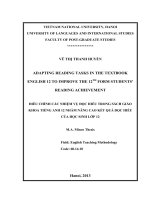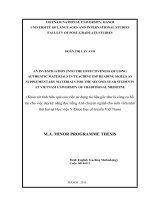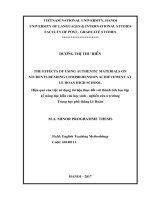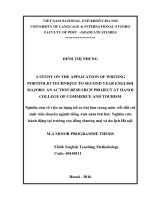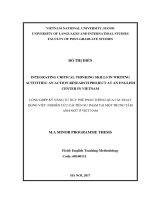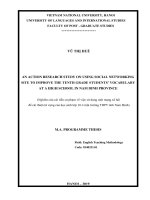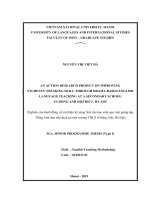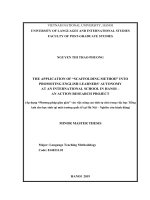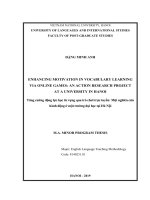An action research project on the effectiveness of using authentic materials on the internet to improve 12th form students extensive reading at b phu ly high school
Bạn đang xem bản rút gọn của tài liệu. Xem và tải ngay bản đầy đủ của tài liệu tại đây (663.92 KB, 75 trang )
VIETNAM NATIONAL UNIVERSITY, HA NOI
UNIVERSITY OF LANGUAGES AND INTERNATIONAL STUDIES
FACULTY OF POST - GRADUATE STUDIES
-----***-----
NGUYỄN THỊ THÚY VÂN
AN ACTION RESEARCH PROJECT
ON THE EFFECTIVENESS OF USING AUTHENTIC
MATERIALS ON THE INTERNET TO IMPROVE 12th
FORM STUDENTS' EXTENSIVE READING AT B
PHU LY HIGH SCHOOL
( Nghiên cứu hành động về hiệu quả việc sử dụng tư liệu
nguyên gốc trên Internet để nâng cao kĩ năng đọc mở rộng
của học sinh lớp 12 trường THPT B Phủ Lý, Hà Nam)
M.A MINOR PROGRAMME THESIS
FIELD: ENGLISH METHODOLOGY
CODE: 60140111
HANOI, 2016
VIETNAM NATIONAL UNIVERSITY, HA NOI
UNIVERSITY OF LANGUAGES AND INTERNATIONAL STUDIES
FACULTY OF POST - GRADUATE STUDIES
-----***-----
NGUYỄN THỊ THÚY VÂN
AN ACTION RESEARCH PROJECT
ON THE EFFECTIVENESS OF USING AUTHENTIC
MATERIALS ON THE INTERNET TO IMPROVE 12th
FORM STUDENTS' EXTENSIVE READING AT B
PHU LY HIGH SCHOOL
( Nghiên cứu hành động về hiệu quả việc sử dụng tư liệu
nguyên gốc trên Internet để nâng cao kĩ năng đọc mở rộng
của học sinh lớp 12 trường THPT B Phủ Lý, Hà Nam)
M.A MINOR PROGRAMME THESIS
FIELD: ENGLISH METHODOLOGY
CODE: 60140111
SUPERVISOR: PROF. DR. HOÀNG VĂN VÂN
HANOI, 2016
CERTIFICATION OF ORIGINALITY
I hereby certify that the minor thesis entitled “An action research project on
the effectiveness of using authentic materials on the Internet to improve 12th
form students' extensive reading at B Phu Ly High School” submitted in partial
fulfillment of the requirements for the Degree of Master of Arts at Faculty of PostGraduate Studies, University of Languages and International Studies, Vietnam
National University, Hanoi is my own study, and that it has not been submitted for
any degree to any other universities or institutions. Where other sources of
information have been used, they have been identified and acknowledged.
Signature
Nguyen Thi Thuy Van
i
ACKNOWLEDGEMENTS
To accomplish this study, I am indebted to many people for their thoughtful
help.
First and foremost, I would like to express my most sincere gratitude to my
respectable supervisor, Prof. Dr. Hoang Van Van for his restless and sympathetic
encouragement, and critical feedback, without which my thesis would be far from
completion.
I would also like to acknowledge a particular debt to Assoc. Prof. Le Van
Canh for his valuable advice and patient guidance though he is not my supervisor.
My sincere thanks also go to my dear colleagues at B Phu Ly High School
for all their help, supports and encouragement when I encountered difficulties.
I wish to acknowledge my thankfulness to classes 12A2 and 12A3 at B Phu
Ly High School for their enthusiastic participation in the experiment.
Finally, I would like to express my thanks to my friends who were willing to
help me during the course. In particular, I find myself indebted to my family
especially my husband for their love, care and tolerance during the process of
writing this thesis.
ii
ABSTRACT
Extensive reading is believed to develop good reading habits, to build up
knowledge of vocabulary and structures, and to encourage a liking for reading.
Materials for extensive reading are available everywhere but Internet-based
materials seem to be the most suitable for high school students because the World
Wide Web now is easily accessible with an endless supply of authentic materials in
the target language where students can start on their own. The use of authentic
materials in extensive reading is appropriate since they relate directly to the real
world. Other aspects which prove positive when using authentic materials are that
they are highly motivating, giving a sense of achievement when understood and
encourage further reading. However, there has been insufficient research to explore
the effects of extensive reading that utilizes authentic materials. Thus, this study is
conducted, adapting action research approach, to investigate the impact of authentic
materials as the main source of extensive reading and students' attitudes toward
these materials. The findings indicate a positive effect of authentic materials on
students’ language competence and favorable opinions from students.
iii
TABLE OF CONTENTS
CERTIFICATION OF ORIGINALITY ................................................................. i
ACKNOWLEDGEMENTS ..................................................................................... ii
ABSTRACT ............................................................................................................. iii
TABLE OF CONTENTS ........................................................................................ iv
LIST OF ABBREVIATIONS................................................................................. vi
LIST OF TABLES ................................................................................................. vii
PART A: INTRODUCTION ....................................................................................1
1. Rationale of the study .......................................................................................1
2. Aims of the study and research questions ......................................................2
3. Hypothesis: ........................................................................................................2
4. Scope of the study .............................................................................................2
6. Method of the study ..........................................................................................3
7. Organization of the study .................................................................................3
PART B: DEVELOPMENT.....................................................................................5
CHAPTER 1: THEORETICAL BACKGROUND AND LITERATURE
REVIEW.....................................................................................................................5
1.1. Extensive reading ...........................................................................................5
1.1.1. Reading ....................................................................................................5
1.1.2. Extensive reading....................................................................................6
1.1.3. The roles of extensive reading in language education .........................7
1.2. Authentic materials........................................................................................9
1.2.1. Definition .................................................................................................9
1.2.2. The use of online authentic materials in improving extensive
reading comprehension ....................................................................................9
1.2.3. Advantages and disadvantages of using authentic materials ...........11
1.3. Attitude .........................................................................................................13
1.3.1. Definition ...............................................................................................13
1.3.2. The effects of attitude in second language learning ..........................15
iv
1.4. Some related studies ....................................................................................16
CHAPTER 2: RESEARCH METHODOLOGY .................................................18
2.1. Research context ..........................................................................................18
2.3. Research approach ......................................................................................19
2.3.1. An overview of action research ...........................................................19
2.3.2. Rationale for the use of an action research ........................................20
2.4. Description of the research .........................................................................21
2.4.1. Population .............................................................................................21
2.4.2. Data collection instruments .................................................................22
2.4.3. The action procedures ..........................................................................23
2.4.4. Data collection procedures...................................................................26
2.4.5. Data analysis procedure .......................................................................27
2.5. Summary.......................................................................................................28
CHAPTER 3: FINDINGS AND DISCUSSION ...................................................29
3.1. Initial data ....................................................................................................29
3.2. Research question 1 .....................................................................................30
3.3. Research question 2 .....................................................................................32
3.3.1. Students’ attitudes towards authentic materials ...............................32
3.3.2. Students’ suggestions for future program..........................................36
3.3.3. Conclusion .............................................................................................37
PART C: CONCLUSION.......................................................................................39
1. Conclusion .......................................................................................................39
2. Implications .....................................................................................................40
3. Limitations of the study ..................................................................................41
REFERENCES ........................................................................................................43
APPENDIX I: PRE-QUESTIONNAIRE FOR STUDENTS ................................ I
v
LIST OF ABBREVIATIONS
ANCOVA: Analysis of Covariance
EFL:
English as a Foreign Language
ESP:
English for Special Purposes
GCSE:
General Certificate of Secondary Education
L2:
Second Language
SPSS:
Statistical Packages for Social Sciences
vi
LIST OF TABLES
Table 1: Advantages & Disadvantages of Authentic Materials
Table 2: Range of students' attitudes to target language
Table 3: An overview of an extensive reading program:
Table 4: The levels of students’ interest in reading lessons, their needs and their
attitudes toward reading skills
Table 5: Significant difference between the pretest mean scores of the students
taught using traditional method and that of those using authentic materials
in the teaching of extensive reading.
Table 6: Significant difference between the post-test mean scores of the students
taught using traditional method and that of those using authentic materials
in the teaching of extensive reading.
Table 7: Significant effect of authentic materials in the teaching of extensive
reading.
Table 8: Students’ attitudes towards authentic material program
Table 9: Students’ suggestions for future program
Table 10: Summary of the Research Findings
vii
PART A: INTRODUCTION
This is a study on the influence of authentic materials on learning reading skills.
This chapter starts with the rationale of the study. Then the aims, hypothesis, scope,
significance and method of the study will be presented.
1. Rationale of the study
Reading is an activity that can be considered as a crucial aspect of one's
language ability because this skill helps to develop other language skills and
provides knowledge on the target language. However, many students experience
difficulties in comprehending the reading texts. These difficulties appear because
the students have low motivation and possess limited vocabulary. Students today
have become more passive and reluctant in regard to reading, doing no more than
what is required. Educators are concerned about students' disinterest and therefore,
are endeavoring to find ways and sources to encourage students to read. Textbooks
are widely adopted in classroom teaching but perhaps because textbook materials
often break down language to discrete linguistic points, it may be too formulaic for
students. Additionally, textbooks are never enough, especially for those who are
going to take the 2 in 1 GCSE (General Certificate of Secondary Education) exams
in which English is a compulsory subject. Moreover, time for reading lesson at high
school is limited. There are three English lessons every week and in five or six
lessons, there is only one for reading which means there is not enough time for
reading - the most important language skill. That is the reason why teachers have to
find ways to enhance students to read more. That means students have to read
extensively.
Additionally, most of the coursebooks used in language classrooms are
perceived as traditional materials because they serve a pre-planned goal, so texts are
simplified and exercises are adapted, which sometimes seems impractical to
learners. Therefore, a new concept, "authentic materials" has been established. Most
linguists agree that in language teaching, the use of authentic materials is quite
useful to the learning process because as Baddock (1981) stated, learners find
1
genuine materials or realia more motivating and interesting since one day they will
use their surviving English in the foreign culture. Morton (1999) also claimed that
authentic materials make students familiar with "real" English and they are also
supposed to motivate students. Nunan (1998) argued that the outside world should
be reflected through the materials and this authenticity ought to be related to the
source of the materials, student activities and tasks. In other words, these materials
should include the language and its sociocultural context in which the language is
used together.
From this suggestion and above initial problems, the author decided to do an
action research project on the effectiveness of using authentic materials on the
Internet to improve 12th form students' extensive reading at B Phu Ly High School.
2. Aims of the study and research questions
In conducting this study, the researcher expects to discover the effects of using
authentic materials in the teaching of extensive reading to 12th graders at B Phu Ly
High School. It is hoped to improve students' extensive reading as well as their
language proficiency. In addition, this paper will be carried out to find out students'
attitudes towards the use of authentic materials in extensive reading activity.
Specifically, two main research questions will be addressed:
- To what extent do authentic materials help to improve EFL high school students'
extensive reading ability?
- What are the students' attitudes towards authentic reading materials?
3. Hypothesis:
A hypothesis in this study is that using authentic materials will help EFL high
school students improve their extensive reading ability and these students will take
positive attitudes towards these materials.
4. Scope of the study
The study was conducted on 90 volunteer students from classes 12A2 and 12A3
at B Phu Ly High School during the first semester and restricted to the first semester
of 2015-2016. The study concentrates on whether authentic materials fits the needs
2
of enhancing 12th form students’ extensive reading skill. As a result, the teachers at
B Phu Ly High School are persuaded to adopt this kind of materials in their
teaching not only reading but other language skills.
5. Significance of the study
Once completed, the study will provide an insight into the effects of using
authentic materials on EFL high school students' extensive reading achievement as
well as their attitudes towards using these materials. What will be achieved in this
research may help teachers consider utilizing authentic materials to improve
students' reading comprehension. Moreover, this study will be much beneficial to
students who wonder how to develop their reading skills as well as their language
proficiency.
6. Method of the study
This study is conducted as an action research because action research is the best
choice for the purpose of improving the current state of affairs within educational
context in which the research is carried out. In order to get data, a combination of
different instruments, namely pretest and posttest, and questionnaire, is used. The
data collected through the questionnaire and the two tests will be analyzed by
quantitative method, using an ANCOVA (Analysis of Covariance) through SPSS
(Statistical Packages for Social Science).
7. Organization of the study
The study consists of three parts:
Part A – Introduction: presents the rationale, aim, scope, significance and
method of the study
Part B – Development: comprises three chapters:
- Chapter 1: Theoretical Background and Literature Review covers the
overview of the literature which includes relevant theoretical background and
reviews of related studies concerning extensive reading skill and the use of
authentic materials in language teaching.
3
- Chapter 2: Research Method continues with the research method including
the participants of the study, the instrumentation, the methods and procedures of
data collection and data analysis.
- Chapter 3: Findings and Discussion demonstrates the findings accompanied
by data analysis and discussion.
Part C: Conclusion: recapitulates the major findings of the study and
represents further recommendations for the implementation of authentic materials.
4
PART B: DEVELOPMENT
CHAPTER 1: THEORETICAL BACKGROUND AND LITERATURE REVIEW
In this chapter, a review of literature in theory and practice on authentic
materials and the teaching of reading is provided. First, the definition and role of
reading, especially extensive reading, in language teaching are introduced. Second,
authentic materials and their use in EFL classrooms are presented. Next, the
definition and effect of attitude on language learning are discussed. Following this,
the studies related to the subject conducted are reviewed.
1.1. Extensive reading
1.1.1. Reading
According to Alderson et. al (1987), "The majority of scholars in the field now
agree on the nature of reading: Reading is the process of constructing meaning from
written texts. It is a complex skill requiring coordination of a number of interrelated
sources of information".
Alderson (2000) defines reading as "... an enjoyable, intense, private activity,
from which much pleasure can be derived, and in which one can become totally
absorbed". Reading means different things to different people, for some it is
recognizing written words, while for others it is an opportunity to teach
pronunciation and practice speaking. However, reading always has a purpose. It is
something that we do everyday, it is an integral part of our daily lives, taken very
much for granted and generally assumed to be something that everyone can do. The
reason for reading depends very much on the purpose for reading. Reading can have
three main purposes: for survival, for learning or for pleasure. Reading for survival
is considered to be in response to our environment, to find out information and can
include street signs, advertising and timetables. It depends much on the day-to-day
needs of the readers and often involves an immediate response to a situation. In
contrast, reading for learning is considered to be the type of reading done in the
classroom and is goal oriented. While reading for pleasure is something that does
not have to be done.
5
Therefore, different scholars of different approaches provide different
definitions of reading. However, "In spite of the constant shift in focus throughout
the history of reading research, it has been generally recognized that reading is a
very complicated process involving a variety of factors that interact with one
another" (Kim, 2002). Due to this complex nature of reading and the fact that it is
one of the most important language skills, most scholars in language methodology
agree that there is a need for incorporating multimedia into reading instruction.
Learners should be provided with sufficient scaffolding to be able to achieve more
effective reading comprehension.
1.1.2. Extensive reading
The term "extensive reading" was originally coined by Palmer (1917) to
distinguish it from "intensive reading". The characteristics of extensive reading
include the relatively fast reading of a large amount of longer, easy-to-understand
material, with the reading done mostly outside the classroom and at each student's
own pace and level. There are few, if any, follow-up exercises, because the aim is
for overall understanding rather than word-by-word decoding or grammar analysis.
And instead of an inflexible curriculum, with extensive reading, the material is
generally chose by the students themselves, who can thereby enjoy some small
measure of responsibility for decisions affecting their learning a basic tenet of
communicative teaching (Thompson, 1996).
Therefore, what does extensive reading entail? Successful extensive reading
requires the following (adapted from Maley's list, 2009):
1. Reading often and in a large quantity.
2. Reading in a wide variety of topics and genres.
3. Reading content that is interesting and compelling.
4. Reading books students themselves select.
5. Reading for pleasure and information.
6. Reading is its own reward.
7. Reading at levels appropriate for the readers.
6
8. Reading speed is fast, not slow.
(Berardo, 2006)
From all the above characteristics of extensive reading, a conclusion can be
drawn that: "Extensive reading is reading of a large quantity of material or long
texts, for global or general understanding; with the intention of obtaining pleasure
from the text. Further, because reading is individualized, with students choosing the
books they want to read, the books are not discussed in class". (Bramfort et. al,
1991)
1.1.3. The roles of extensive reading in language education
Various studies already exist in support of extensive reading. Bell (1998) stated
that extensive reading provides substantial linguistic input which is needed for
language acquisition and thus helps develop learners' linguistic competence. Many
researchers point out the importance of extensive reading, the positive effects of
extensive reading in students' reading comprehension. They suggest that one of the
best ways to help students increase their language proficiency is to encourage them
to read extensively. Through experiencing language in context, extensive reading is
a very effective way of reinforcing, confirming and deepening knowledge of
vocabulary, structures, and of developing an implicit understanding of when and
how words are used (Nation, 1997 and Cady, 1997 cited in Mutoh, Bamford and
Helgesen, 1998). And motivation is stimulated by combining the pleasure of "a
good read" with the satisfaction of accomplishing a meaningful task in the target
language. It is also a widely held belief among supporters of extensive reading that,
by eliminating follow-up testing and exhorting students to aim for general
understanding rather than detailed comprehension, they gradually learn to read
without word-by-word decoding at the sentence level. Carrell (1998) stated that the
goal is to turn "learning to read into reading to learn".
Strong (1996) also stated that "extensive reading of literature can encourage
students to develop positive attitudes toward reading".
7
Bell (2011) has clearly identified the role of extensive reading in language
education as follows:
It can provide "comprehensible input".
It can enhance learners' general language competence.
It increases the students' exposure to the language.
It can increase knowledge of vocabulary.
It can lead to improvement in writing.
It can motivate learners to read.
It can consolidate previously learned language.
It helps to build confidence with extended text.
It encourages the exploitation of textual redundancy.
It facilitates the promotion of prediction skills.
The benefits of extensive reading, therefore, extend beyond the acquisition of
reading fluency. Krashen (2004) claimed that "Reading is good for you ... Reading
is the only way, the only way we become good readers, develop a good writing style,
an adequate vocabulary, advanced grammar, and the only way we become good
spellers."
According to Krashen, "What makes it [extensive reading] far more compelling
is that extensive reading not only develops reading skill but also benefits a whole
range of other language skills, boosts confidence and motivation and improve
overall attitude. Reading in this sense has to be seen holistically as a crucial part of
students' total development, not as some separate skill."
Davis (1994) also suggested that any classroom would be the poorer for the lack
of an extensive reading programme and would be "unable to promote its students'
language development in all aspects as effectively as if such a programme were
present".
To sum up, many studies have shown that extensive reading has positive effects
not only on students' reading comprehension skill but also on a variety of language
skills and language development. It has been claimed that free voluntary reading or
8
sustained independent reading results in better reading comprehension, writing style,
vocabulary, spelling, and grammatical development.
1.2. Authentic materials
1.2.1. Definition
Authentic materials have been defined as "... real-life texts, not written for
pedagogic purposes" (Wallace, 1992). Gilmore (2007) and Morrow (1977) both
claimed that authentic materials contain "real language, produced by a real speaker
for a real audience and designed to convey a real message of some sort". They are
"... materials that have been produced to fulfill some social purpose in the language
community." (Peacock, 1997), in contrast to non-authentic texts that are especially
designed for language learning purposes.
Therefore, authentic materials are any texts written by native speakers for native
speakers of certain language and will be used by the speakers of the language in
communication circumstances outside language classroom. Thus, most everyday
objects in target language whether spoken or written such as magazines, newspapers,
tourism brochures, advertisements, menus, recipes can be included as authentic
materials, but for developing reading, one of the most useful sources is the Internet
with large amounts of varied materials being easily accessible.
1.2.2. The use of online authentic materials in improving extensive reading
comprehension
After a careful review of literature, the researcher finds that the use of authentic
material has been strongly debated because of its complexity in vocabulary and
structures especially for lower-level learners. However, Gilmore (2007) pointed out
that authentic materials have been used for language learning for several decades
and have regained their popularity due to the rise of the communicative approach.
The goal of the communicative approach is to develop language competence for
communication in real life. Textbooks are often written with classroom dialogue
practices that are artificial, thus presenting a gap from real life language. In contrast,
9
authentic materials are believed to generate greater interest among teachers,
students and even publishers than do traditionally structured materials.
Floris (2008) claimed the necessity for incorporating authentic materials in the
course design because they are more motivating and engaging, and relevant to
students' lives. Other researchers stated that authentic materials provide
opportunities for language use in a more relevant and communicative way (Sánchez,
Pérez, and Gómes, 2010). Huang (2005) pointed out the importance of authentic
materials because when at an adequate level, they elevate learners' sensitivity to and
competence in the language. Littlewood (1992) brought attention to several
considerations in the adoption of authentic materials: learners' needs, their interest
in topics, language situations and functions students would find useful. Nunan
(1992) also suggested giving students their own choice of materials and the
incorporation of student-produced materials as another component of authentic texts.
The wide variety of authentic materials ranges from literature, CDs, DVDs,
news, movies, songs, TV programs, even to brochures and menus but the utilization
of authentic materials from online resources is particularly valuable and easily
accessible. Internet technology is a "medium of global communication and a source
of limitless authentic materials" (Warschauer, 1996). Whereas newspapers and any
other printed materials date very quickly, the Internet is continuously updated, more
visually stimulating as well as being interactive, therefore promoting a more active
approach to reading rather than a passive one. From a more practical point of view,
the Internet is a modern day reality, most students use it and for teachers there is
easier access to endless amount of many different types of materials. From an even
more economical viewpoint, looking for materials costs almost nothing, only time,
by having unlimited access in the work place. Additionally, online authentic
materials enable students to interact with the real language and content rather than
the form. Learners feel that they are learning a target language as it is used outside
the classroom.
10
1.2.3. Advantages and disadvantages of using authentic materials
While since the late 1970's authentic materials have been regarded as being
superior to simplified textbook materials, there have still been some arguments
about their use and effectiveness.
On one hand, there are some advantages of utilizing authentic materials. They
are: original, interesting, motivating and useful (Peacock, 1997). The term original
relates to authenticity. Authenticity means that nothing of the original text is
changed and also that its presentation and layout are retained (Grellet, 1996).
Authentic materials are often regarded as more interesting than the textbook
materials because they can be up to date and related to everyday issues and
activities. The use of authentic materials can motivate the students because there are
three layers of learning which are: language learning (the structure and vocabulary),
cultural insight, and practical application (Speller, 2002). Authentic materials are
useful because they help students to break the gap between the language classroom
and the real life situation. They introduce students to the culture that surrounds them
and provide them the opportunities to see where different grammatical structures
and types of discourse are used. Horwitz (2008), stated that when there is an aim of
intensive reading both authentic and constructed materials are advised to be used
while for extensive reading, authentic materials are preferred.
Along with the advantages, the use of authentic materials also brings some
disadvantages. The grammar and vocabulary in authentic materials may be too
difficult for foreign language learners because authentic materials are used for
communicating and informing in the society, thus they might use some
abbreviations, slangs or informal words. Besides, the content of the text is
sometimes not appropriate for the students. Berardo (2006) gave a table of
advantages and disadvantages of authentic materials as follows:
11
Table 1: Advantages & Disadvantages of Authentic Materials
Authentic Materials
Advantages
Disadvantages
- "Real" language exposure with language - Often too cultural biased, difficult
change/variation being reflected.
to understand outside the language
- Students are informed about what is community.
happening in the world.
-
Textbooks
tend
incidental/improper
- Vocabulary might not be relevant
not
to
include to the student's immediate needs.
English
and
become - Too many structures are mixed so
outdated very quickly.
lower
levels
have
problems
- The same piece of material can be used for decoding the texts.
different tasks.
- Special preparation is necessary,
- Ideal for teaching/practicing mini-skills- can be time consuming.
skimming/scanning.
- Can become outdated easily, e.g.
- Contain a wide variety of text types, news stories, articles.
language
styles
not
easily
found
in
conventional teaching materials.
- Encourage reading for pleasure, likely to
contain topics of interest.
(Berardo, 2006)
In order to avoid these disadvantages, the teacher should be selective in
choosing the materials before delivering them to the students. Teacher should
consider the suitability and the readability of the text. In addition, in teaching and
learning process, the teacher should guide the students in understanding the text and
also in finding the difficult words. Berardo (2006) suggests teachers consider 4
important factors in choosing authentic reading materials:
Suitability of content:
Does the text interest the student?
Is it relevant to the student's needs?
12
Does it represent the type of material that the student will use outside
the classroom?
Exploitability:
Can the text be exploited for teaching purpose?
For what purpose should the text be exploited?
What skills/strategies can be developed by exploiting the text?
Readability:
Is the text too easy/difficult for the student?
Is it structurally too demanding/complex?
How much vocabulary does it contain?
Presentation:
Does it "look" authentic?
Is it "attractive"?
Does it grab the student's attention?
Does it make him want to read more?
All these studies and research on the use of authentic materials indicate that the
use of authentic materials in language teaching has generally been effective.
Nevertheless, there are some limitations and drawbacks in employing them with
EFL learners.
1.3. Attitude
1.3.1. Definition
According to Longman’s Dictionary of Contemporary English, attitude is "a
way of feeling or thinking about someone or something, especially, as this
influences one’s behavior".
Language attitudes, however, are different from other general attitudes in the
sense that they are specifically about language. We normally believe that language
attitudes are concerned with attitudes with regard to the language itself – its variety,
its sound system, its semantic quality and so on and so forth. In fact the term
language attitude as it is applied by sociolinguists today, includes the outlook and
13
stance towards speakers of a particular language as also a variety of behavior
concerning language.
Ellis (2000) mentioned that positive attitudes towards the L2 and its speakers
can be expected to enhance learning while negative attitudes impede it. Therefore,
learner attitudes have an impact on the level of L2 proficiency achieved by
individual learners who are themselves influenced by this success. Thus, learners
with positive attitudes, who experience success, will have these attitudes reinforced.
Similarly, learners’ negative attitudes may be strengthened by lack of success. (Ellis
2002).
Baker (1988) suggested that attitudes are complex constructs; there may be both
positive and negative feelings attached to a language situation. According to
Lambert (1967), attitudes consist of three components - the cognitive, affective and
conative (related to action) components. The cognitive component refers to an
individual’s belief structure, the affective to emotional reactions and the conative
component includes the tendency to behave in a certain way towards the attitude.
According to Allport (1995), "an attitude is a mental and neural state of
readiness, organized through experience, exerting as directive or dynamic influence
upon the individual's response to all objects and situations with which it is related."
Ajzan (1998) stated that attitude is "a disposition to respond favourably or
unfavourably to an object, person, institution, or event."
Wenden (1991) as cited in Atez & Munir (2009) gave a broader definition of
the concept "attitude". He claimed that the term "attitudes" includes three
components namely, cognitive, affective, and behavioural. A cognitive component
is comprised of the beliefs and ideas or opinions about the object of the attitude.
The affective one is made up of the feeling and emotions that one has towards an
object, "likes" or "dislikes", "with" or "against". Finally, the behavioural component
refers to one's consisting actions or behavioural intentions towards the object.
To sum up, attitude is a mental and neural state, expressing the individual's
responses to an object, a person, a thing or an event.
14
1.3.2. The effects of attitude in second language learning
The concept of learners' attitude has been the focus of attention in explanation
and investigation of human behavior offered by social psychologists. Attitude is
usually defined as a disposition or tendency to respond positively or negatively
towards a certain thing such as an idea, object, person, or situation. A large number
of studies have investigated the relationship between attitude and proficiency in the
language (Bachman, 1990; Coleman, Strafield, and Hagan, 2003). Gardner (1985)
believed that attitude and other affective variables are as important as aptitude for
language achievement.
According to Ismet (2005), attitude is one of "the determinants of success in
EFL learning". Depending on the learners' attitudes, learning language can be a
source of enrichment or a source of resentment. Positive attitudes towards L2 is
beneficial to L2 learners because positive attitudes help to create motivation to
achieve success in acquiring that language (Holmes, 1992); whereas, negative
attitudes towards the foreign language and group which often comes from
stereotypes, can impede the learning of that language (Brown, 2000).
Gardner's socio-educational model strengthens the interrelationship between
success and attitude. His theory is based on the idea that L2 learning is "acquiring
symbolic elements of a different ethnolinguistic community" (Gardner, 1979). The
proponents of the model believe that the relationship between learners' attitudes and
their proficiency is an indirect one, unlike that between integrative motivation and
proficiency which is described as more direct and, therefore, stronger.
Discussing the students' attitudes to the L2 learning, Stern (1992) gives the
below figure:
Table 2: Range of students' attitudes to target language
Very
Positive
Neutral
positive
- Enthusiastic - Enters into -
Negative
Very
negative
Recognizes, - Finds it hard - Finds L2
15
about L2
-
spirit of L2
tolerates,
Enjoys - Feels at accepts L2
listening
to, home in L2
speaking,
-
and to accept L2
- L2 strange
Acknowledges -
- Feels good differences
odd,
annoying,
Feels confusing,
and uncomfortable
reading, and and
difficulties
writing L2
confident
- Has no marked about
- Praises L2
about L2
sense of discomfort aspects of L2
and ugly
and disoriented - Rejects L2
most
or disorientation
(Stern, 1992)
In sum, from these studies into the learners' attitudes towards L2 learning, it can
be concluded that learners' attitudes play a significant role in enabling learners
effectively. Having positive or negative attitudes towards a certain language can
exert considerable influence upon their performance on the language itself.
Consequently, L2 teachers need to take learners' attitudes into consideration.
Teachers should be aware of a positive correlation between language learners'
attitude and language proficiency. This awareness can help language teachers make
decision about their teaching, and this decision making can call for some teaching
implications which refer to teaching practice orientation to learners' attitudes.
1.4. Some related studies
Recently, authentic materials have been paid more and more attention by
several researchers.
Berardo (2006) in “The use of authentic materials in the teaching of reading”,
investigated if authentic materials were effective. He found out that students
benefited from the exposure to real context and students were highly motivated
giving a sense of achievement when understood and encouraged further reading.
In another study “A review on the effectiveness of using authentic materials in
ESP courses”, Baghban and Pandian (2011) stated that authentic materials, being
part of the real world, can serve as excellent resources for introducing language in
16
